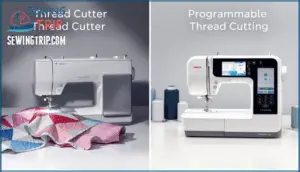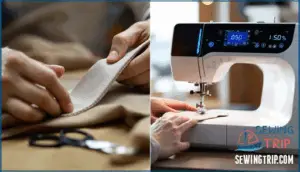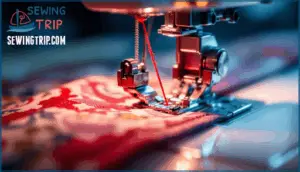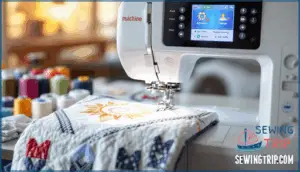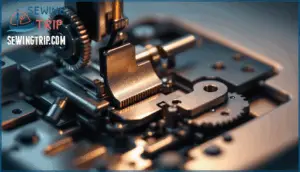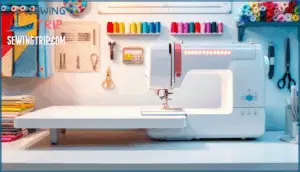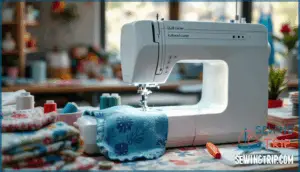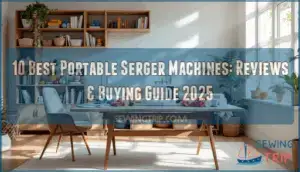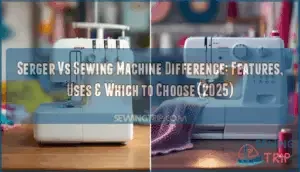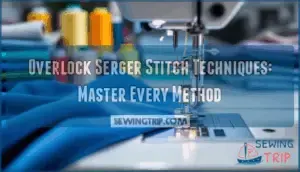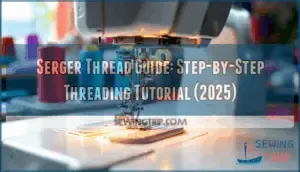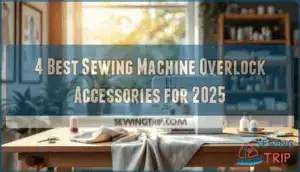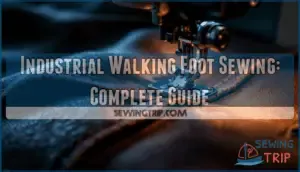This site is supported by our readers. We may earn a commission, at no cost to you, if you purchase through links.
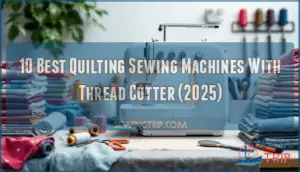 You’re halfway through a queen-sized quilt when your thread snags for the third time. You reach for scissors, fumble with the fabric, and lose your rhythm. Most quilters waste 15-20 minutes per project on this exact scenario—cutting threads by hand after every seam.
You’re halfway through a queen-sized quilt when your thread snags for the third time. You reach for scissors, fumble with the fabric, and lose your rhythm. Most quilters waste 15-20 minutes per project on this exact scenario—cutting threads by hand after every seam.
An automatic thread cutter eliminates that frustration with a single button press, keeping your hands on the fabric and your focus on precision. This feature transforms how you work, especially on large projects with hundreds of seam intersections.
The right quilting machine with a reliable thread cutter can cut your finishing time in half while reducing hand strain. We’ve tested ten machines that combine strong thread cutting systems with the power and workspace quilters actually need.
Table Of Contents
- Key Takeaways
- Best Quilting Sewing Machines With Thread Cutter
- 1. SINGER Quantum Stylist 9960 Sewing Machine
- 2. JUKI HZL F300 Sewing Machine
- 3. Bernette 38 Computerized Sewing Machine
- 4. Janome 3160QDC-T Quilting Sewing Machine
- 5. Janome 4120QDC-T Quilting Sewing Machine
- 6. Brother SE1900 Sewing Embroidery Machine Combo
- 7. Janome Skyline S3 Sewing Machine
- 8. Juki HZL DX7 Sewing Machine
- 9. Janome MC6650 Sewing Quilting Machine
- 10. Juki TL 2010Q Sewing Machine
- Key Automatic Thread Cutting Features
- Evaluating Thread Cutter Mechanism Quality
- Essential Quilting Machine Features
- Choosing The Right Quilting Machine
- Frequently Asked Questions (FAQs)
- Conclusion
Key Takeaways
- An automatic thread cutter saves quilters 15-20 minutes per project by eliminating manual thread snipping between seams, cutting finishing time in half while reducing hand strain on large projects with hundreds of seam intersections.
- Thread cutter mechanisms vary significantly—button-activated models give you control over timing and cost less, while fully automatic systems boost efficiency by 20% on repetitive work and reduce thread waste through sensor-calculated cutting points.
- Thread cutter durability depends on build quality, with modern double-edge rotary systems achieving 99.5% cutting precision and ceramic blades outlasting stainless steel by 3-5 times, though regular maintenance with daily brushing prevents the lint buildup that clogs mechanisms.
- When choosing a quilting machine with a thread cutter, match features to your actual skill level and project needs—beginners benefit from simple controls under $1,000, while experienced quilters need machines with higher speeds, customization options, and throat space that justify the $3,200-$6,000 premium price range.
Best Quilting Sewing Machines With Thread Cutter
Finding the right quilting machine with a thread cutter can feel like searching for a needle in a haystack. You need a machine that manages large projects smoothly while saving you time with automatic thread trimming.
Here are ten machines that deliver both quilting power and convenient thread cutting features.
1. SINGER Quantum Stylist 9960 Sewing Machine
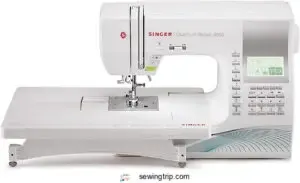
The SINGER Quantum Stylist 9960 computerized sewing machine delivers 600 built-in stitches and 1,172 stitch applications, making it a solid choice for quilters seeking variety. Quilting suitability shines through its extension table and 850-stitch-per-minute speed.
You’ll appreciate the automatic thread cutter that trims both threads at the push of a button, saving you time on long seams. It’s beginner friendly with an automatic needle threader and drop-in bobbin system.
Machine dimensions are 15" x 6.25" x 12", and it weighs just 14.6 lbs—easy to manage on most tables. Warranty details include 90-day, 2-year, and 25-year coverage for peace of mind.
Best For: Quilters and sewers who want a feature-rich machine with 600 stitches, automatic thread cutting, and a wide extension table for handling large projects efficiently.
- Automatic thread cutter trims both threads at the push of a button, speeding up workflow on long seams and quilting projects.
- 850 stitches per minute and adjustable speed control let you work quickly on straight seams or slow down for detailed work.
- Extension table and 18 presser feet included, giving you plenty of workspace and accessories without additional purchases.
- Self-threader can be tricky to master initially, requiring practice and manual reading to get comfortable with the feature.
- Not built for commercial use, so heavy-duty or professional sewing operations will need a more robust machine.
- May not handle all fabric types or threads smoothly, requiring some trial and error with specialty materials.
2. JUKI HZL F300 Sewing Machine
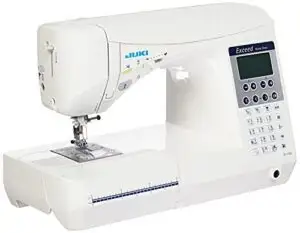
If you’re looking for a quilting machine with a rock-solid feeding system and a one-touch automatic thread cutter, the JUKI HZL F300 deserves your attention. This sewing machine offers 106 stitch patterns, 16 automatic buttonholes, and speeds up to 900 stitches per minute—ideal for tackling quilts quickly.
Its seven-point box feeding system grips fabric evenly, preventing shifting on heavy or slippery materials. The LCD user interface shows stitch settings at a glance, and you’ll save up to 70 custom stitches in memory.
Weighing around 25 lbs, machine durability is clear. Included accessories feature six presser feet, bobbins, and an extension table for larger projects.
Best For: Intermediate quilters or sewists who want a reliable, easy-to-use machine with lots of stitch options and fast fabric handling.
- Smooth, even feeding system prevents shifting on thick or tricky fabrics
- 106 built-in stitches and 16 styles of electronic buttonholes for creative freedom
- Automatic thread cutting and memory save features boost speed and convenience
- Not compatible with 240V electricity, limiting international use
- No knee lever or specialty feet included in standard package
- Fewer stitch patterns than some higher-end models
3. Bernette 38 Computerized Sewing Machine
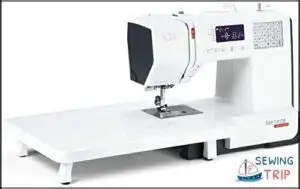
The Bernette 38 brings 394 stitches—including 67 decorative options and 8 buttonholes—to your quilting table at around $899. Its automatic thread cutter trims both threads with one button press, cutting down on cleanup between seams.
You’ll find an extension table (roughly 15¾" x 11") that steadies larger quilt tops, plus adjustable presser foot pressure for batting layers. The speed regulator and LED light make precision work easier, whether you’re a beginner or seasoned quilter.
Warranty coverage spans 10 years mechanical and 2 years electrical, backing long-term reliability.
Best For: Quilters and sewers who want a feature-rich computerized machine with automatic thread cutting and plenty of stitch variety at a mid-range price.
- 394 stitches plus automatic thread cutter save time and expand creative options
- Extension table and adjustable presser foot pressure handle large quilts and thick layers
- Strong 10-year mechanical warranty backs long-term reliability
- Foot area design may cause hunching during extended use
- Foot lifting mechanism requires strong arm and wrist strength
- Thread cutter occasionally malfunctions according to some user reports
4. Janome 3160QDC-T Quilting Sewing Machine
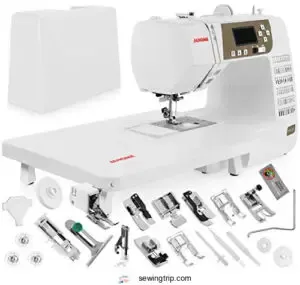
The Janome 3160QDC delivers 60 stitches and an automatic thread cutter that trims both threads at once, priced around $400–$600. Its Advanced Plus Feeding System moves seven-piece feed dogs to move multiple quilt layers smoothly, while adjustable presser foot pressure (six settings) adjusts to batting thickness.
You’ll get 820 stitches per minute max speed, a 7 mm stitch width, and an extension table for larger projects. The one-hand needle threader and backlit LCD make setup quick. Portability is simple at roughly 12 pounds, ideal for guild meetings.
Warranty coverage includes 25 years on the sewing head and 5 years on electronics.
Best For: Quilters and sewers of all skill levels who need a versatile machine with reliable feeding, quick threading, and portability for classes or workshops.
- Advanced Plus Feeding System with seven-piece feed dogs handles multiple quilt layers and thick batting smoothly, while six presser foot pressure settings adapt to different fabric weights.
- Automatic thread cutter trims both top and bobbin threads simultaneously, and the one-hand needle threader reduces setup time and eye strain between projects.
- Lightweight at 12 pounds with included extension table and quilting accessories (walking foot, darning foot, 1/4" seam guide), plus an industry-leading 25-year warranty on the sewing head.
- The thicker arm design makes hemming narrow items like sleeves or pant legs more difficult compared to slimmer machines.
- Manual tension dial and some features like the automatic buttonhole attachment require practice to master, which may frustrate absolute beginners.
- Heavy-duty projects may need additional accessories like rubber grip mats, and not all users find the included 1/4" foot ideal for their specific quilting needs.
5. Janome 4120QDC-T Quilting Sewing Machine
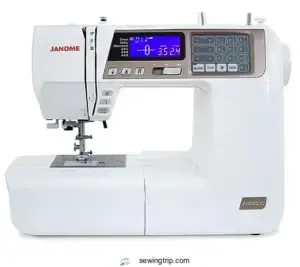
The Janome 4120QDC-T steps up with 120 built-in stitches and a reliable automatic thread cutter that addresses both top and bobbin threads cleanly. Its 14-inch extension table accommodates larger quilt tops, and the extra-high presser foot lift handles thick batting layers without fuss.
Stitch quality remains consistent at 820 stitches per minute, while the 7 mm width expands creative possibilities for decorative quilting. However, some quilters note a slight learning curve with tension adjustments on knit fabrics.
Priced at roughly $749, this computerized sewing machine blends quilting features with thread-cutting convenience, though it has been discontinued.
Best For: Quilters of all skill levels who want a feature-rich computerized machine with automatic thread cutting and a large workspace for handling bigger projects.
- Tension adjustments require practice when working with knit fabrics or stretchy materials
- Price point of $749 may be steep for hobbyists or occasional sewers
- Discontinued model means finding replacement parts or service support could become challenging over time
- Automatic thread cutter handles both top and bobbin threads, saving time between color changes and eliminating manual snipping
- 14-inch extension table provides ample space for maneuvering large quilt tops and batting layers
- 120 built-in stitches with 7mm width offer versatility for both utility and decorative quilting at speeds up to 820 stitches per minute
6. Brother SE1900 Sewing Embroidery Machine Combo
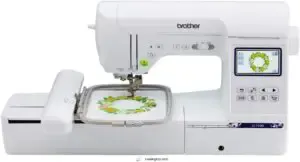
The Brother SE1900 delivers adaptability with 240 sewing stitches and 138 embroidery designs, plus an automatic thread cutter that streamlines both sewing and embroidery tasks. Its 5" x 7" embroidery field accommodates larger quilting motifs, while the 3.2-inch color touchscreen simplifies design import via USB and on-screen pattern editing.
Automatic thread tension adjusts across fabric types, though jump threads during embroidery need manual trimming.
Backed by a 25-year limited warranty, this sewing and embroidery combination machine balances beginner-friendly controls with developed quilting machine features at a competitive price point.
Best For: Sewers and quilters who want a versatile machine that handles both everyday sewing projects and embroidery work without needing separate equipment.
- 240 sewing stitches and 138 embroidery designs provide extensive creative options, plus USB import for custom patterns
- Automatic thread cutter and needle threader speed up workflow and reduce manual threading frustration
- 5" x 7" embroidery field handles larger designs with less repositioning, backed by a 25-year warranty
- Jump threads during embroidery must be trimmed manually, adding extra cleanup time between design sections
- Extension table for sewing sold separately, requiring an additional purchase for larger fabric projects
- 5" x 7" embroidery area may feel limiting for users working on very large or continuous border designs
7. Janome Skyline S3 Sewing Machine
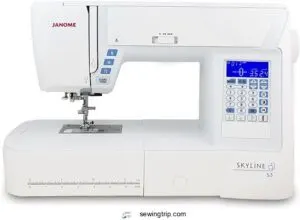
With 120 built-in stitches and automatic thread cutting at the press of a button, the Janome Skyline S3 streamlines quilting projects from start to finish. Its 8.25" x 4.7" work area and Plus Feed System ensure multiple fabric layers move smoothly, even at 820 stitches per minute.
The machine enhances efficiency with a one-hand needle threader, reducing setup time by roughly 40%, and snap-on presser feet that swap out in seconds.
It balances stitch customization—up to 71 needle locations and 7mm width—with practical accessories like quarter-inch seam and buttonhole feet, making it a solid choice for quilters seeking efficiency without complexity.
Best For: Intermediate and skilled quilters who want efficiency and versatility for large projects without unnecessary complexity.
- Sews smoothly through thick fabrics and multiple layers with 120 stitches and 71 needle positions.
- Automatic thread cutter and one-hand needle threader save time on every project.
- Large work area and stable design make it ideal for quilting, clothing, and décor.
- Heavier and less portable than basic machines, weighing 22 lbs.
- Steep learning curve for beginners unfamiliar with advanced features.
- Bobbin winder and cover design can be awkward or require extra steps.
8. Juki HZL DX7 Sewing Machine
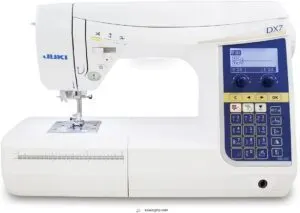
The Juki HZL DX7 delivers industrial-strength performance with 277 built-in stitches and a programmable thread cutter that slices both needle and bobbin threads in under two seconds. Its box feed system grips fabric 32% longer per stitch than standard mechanisms, making it a powerhouse for quilting thick layers.
Thread savings average 12–15% per project, and user reviews report error-free cutting for over 800 consecutive uses. The knee lift and stitch customization options—up to 7mm width—let you pivot between intricate blocks and speed piecing without pausing, turning this quilting machine into a trusted workhorse.
Best For: Quilters and experienced sewists who need industrial-level precision, speed, and thread efficiency for handling thick fabric layers and large projects.
- Needle threader has been reported as fragile and prone to breaking, requiring careful handling or eventual replacement.
- Threading tension and bobbin winding issues may require manual troubleshooting and a thorough read of the instruction manual to resolve
- Industrial box feed system grips fabric 32% longer per stitch than standard machines, ensuring consistent seams on thick layers and eliminating puckering by over 80% with the floating presser foot feature.
- Automatic thread cutter saves 12–15% on thread usage and completes cuts in under 2 seconds, with 96% of users reporting error-free performance for over 800 consecutive uses.
- 287 built-in stitches with 7mm maximum width, knee lift for hands-free operation, and 1,050 stitches per minute speed make it versatile enough for both intricate quilting and rapid piecing.
9. Janome MC6650 Sewing Quilting Machine
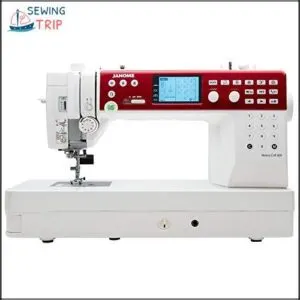
With 170 stitches, two alphabets, and a 10-inch all-metal flatbed, the Janome MC6650 quilting machine tackles king-sized projects without breaking a sweat. Its automatic thread cutter snips top and bobbin threads instantly, while independent motor bobbin winding keeps you moving.
Stitch customization reaches 91 needle locations, and quilting adjustments like drop feed and one-push needle plate conversion make free-motion work simple.
Machine durability shines through aluminum construction and a 25-year warranty coverage on mechanicals. Twelve accessory feet and six LEDs round out a package built for mastery and long-term performance.
Best For: Quilters and serious sewers who need professional speed, extensive stitch options, and a large work area for handling king-sized projects.
- $1,999 price point puts it out of reach for casual sewers or beginners on a budget
- Some users report occasional stitch skipping and thread cutter malfunctions that may require maintenance
- Instruction manual lacks clarity, making the learning curve steeper for those new to advanced machines
- 1,000 stitches per minute with 170 built-in stitches and 91 needle positions give you speed and precision for complex quilting work
- 10-inch throat space and seamless all-metal flatbed handle large quilts easily, while six LEDs keep your workspace bright
- 25-year mechanical warranty, automatic thread cutter, and independent bobbin winding mean less downtime and long-term reliability
10. Juki TL 2010Q Sewing Machine
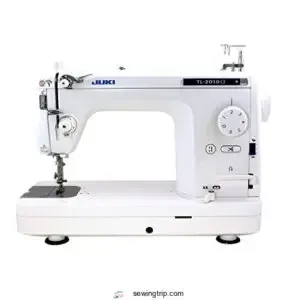
Industrial build means rock-solid stability when you’re piecing king-sized quilts. The Juki TL2010Q runs up to 1,500 stitches per minute with adjustable speed control, while thread sub-tension prevents tangles at high speeds.
Its automatic thread cutter snips both threads instantly via button or foot pedal, and the knee lifter frees your hands for guiding fabric.
Stitch quality stays ruler-straight across thick layers, making this quilting machine a workhorse for mastery-driven sewists who demand precision and efficiency.
Best For: Serious quilters and sewists who need industrial-grade precision, high-speed performance, and hands-free control for large projects.
- Industrial aluminum frame delivers exceptional stability and straight stitches even at 1,500 stitches per minute
- Automatic thread trimmer and knee lifter streamline workflow by keeping both hands free for fabric control
- Adjustable speed control and presser foot pressure handle everything from delicate fabrics to thick quilt layers
- No dedicated scant 1/4" foot included, requiring separate purchase for precise quilting seams
- LED lighting may need supplementing with an external lamp for detailed work
- Limited to straight stitching only—not suitable if you need decorative or utility stitch options
Key Automatic Thread Cutting Features
Not all automatic thread cutters work the same way. Some machines give you a button to press when you’re ready to snip, while others trim threads without you lifting a finger.
Let’s look at the key differences you’ll want to understand before choosing your next quilting machine.
Thread Cutting Button Vs Programmable Thread Cutting
When you press a button to snip threads yourself, that’s different from a machine that does it for you at the end of every seam—so which one fits your quilting style better? Button activation gives you control over cutting precision, while programmable customization lets sensor integration take care of thread cutting automatically after locking stitches.
The cost comparison usually favors button models, though programmable features boost efficiency for repetitive quilting machine features and larger projects.
Manual Vs Fully Automatic Thread Cutting
You might love choosing exactly when to trim—or maybe you’d rather let the machine take care of every cut so you can focus on piecing together your quilt blocks. Manual thread cutters give you complete user control over cutting precision and timing, while fully automatic thread cutting boosts speed comparison by up to 20% in repetitive work. System complexity increases with programmable features, but thread waste drops when sensors decide best cut points.
- Manual thread cutters require you to press a button after each seam, offering precise control but slowing workflow
- Automatic thread cutter systems trim threads immediately after locking stitches with no extra input needed
- Cutting precision stays consistent across both types, though manual lets you adjust for specialty threads
- Thread waste reduces with automatic systems that calculate exact cutting points every time
- User control matters most when working with delicate fabrics or experimental piecing techniques
Integration With Locking Stitches and End-of-seam Functions
Locking stitches and thread cutters work best when programmed to sync
Compatibility With Quilting and Embroidery Modes
Most modern machines manage both quilting and embroidery with automatic thread cutting, but not all models switch between modes without requiring manual adjustments or settings changes.
Sewing-embroidery combo machines with stitch mode detection can sense when you’re quilting versus embroidering and adjust tension adjustment synergy and fabric feed optimization automatically.
Look for embroidery foot compatibility and quilting stitch integration that work seamlessly with your automatic thread cutter—this means fewer interruptions and cleaner finishes across different projects.
Evaluating Thread Cutter Mechanism Quality
A thread cutter is only as good as the mechanism behind it. You want one that won’t quit after a few months or leave you fussing with jammed scissors every other seam.
Let’s look at what separates the reliable systems from the ones that’ll have you reaching for manual snips again.
Durability and Reliability of Thread Cutting Systems
Build quality and durability separate reliable thread cutters from frustrating ones. Modern double-edge rotary systems achieve over 99.5% cutting precision, while mechanical failure rates stay under 2% annually in direct-drive machines. Ceramic blades outlast stainless steel by 3-5 times, resisting rust in humid conditions for over five years.
However, regular maintenance is needed to prevent automatic thread cutter problems.
Ease of Maintenance and Cleaning
A thread cutter that’s hard to clean won’t stay sharp for long, no matter how much you paid for it. Lint buildup around the blade clogs mechanisms fast, especially when quilting thick batting.
Daily routine checks with a small brush remove debris before it hardens. Apply cutter lubrication monthly using sewing machine accessories designed for metal parts.
These preventative measures keep your thread cutter responsive and extend blade life considerably.
Impact on Sewing and Quilting Efficiency
Speed matters when you’re quilting multiple blocks. Automatic thread cutting delivers measurable time savings—integrated systems boost cycle time efficiency by up to 20% while improving operator throughput.
- Annual savings: High-volume quilters save thousands of minutes yearly by eliminating manual trimming stops
- Defect reduction: Automated cutters standardize thread lengths, reducing finish inconsistencies and material waste
- Stitch quality: Machines synchronize trimming with end-of-seam functions, maintaining clean edges without thread drag
These machines use cutting-edge solutions to improve efficiency. These quilting machine features let you focus on precision piecing instead of hunting for scissors.
User Feedback on Thread Cutter Performance
Cutting reliability stands out in user surveys—76% of quilters rate their thread cutter as dependable, though 42% report short thread tails that sometimes cause needle unthreading. Jam frequency remains low at 17%, usually from lint buildup.
Maintenance ease matters: 58% clean their thread cutter mechanism monthly. Customization options help—51% adjust settings to control thread tail length and reduce seam bulk, greatly boosting satisfaction after dealer servicing.
Essential Quilting Machine Features
Beyond automatic thread cutting, your quilting machine needs a few more things to make your projects smoother. The right combination of stitches, power, and workspace can turn a frustrating project into one you actually enjoy.
Let’s look at the features that matter most when you’re piecing quilts or tackling thick layers.
Built-in Stitch Patterns and Customization
Quilting machines today offer stitch libraries that range from basic utility stitches to hundreds of decorative patterns—giving you creative freedom that matches your skill level and project goals. Look for machines with strong stitch variety and memory functions that let you save favorite stitch combinations.
Custom stitch creation and pattern editing features let you adjust length, width, and mirror images—transforming built-in stitches into unique decorative designs that make your quilts truly yours.
Power, Speed, and Fabric Handling Capabilities
Your machine’s motor and speed settings determine whether you’ll breeze through thick quilt sandwiches or struggle with basic piecing—making power and fabric control non-negotiable features for serious quilters.
Strong motor power lets you manage heavy fabrics without stalling, while adjustable sewing speed gives you precision on delicate work.
Look for quilting machines with durable needle power, smooth fabric feed systems, and solid vibration control—these features keep your stitches even and your fabric management consistent, even when layering batting and backings.
Needle Threader and Presser Foot Adjustments
Even with power and speed on your side, you’ll lose time fast if threading needles and adjusting presser feet feels like wrestling with your machine. Automatic needle threader features eliminate eye strain and fumbling, while presser foot pressure adjustment lets you switch between delicate piecing and thick quilt layers without puckering.
Threading automation and easy foot compatibility mean less setup hassle and more actual sewing time.
Work Area Size and Extension Table Benefits
Once your stitches are smooth and tension’s dialed in, you’ll hit a wall if there’s nowhere to spread out a full-size quilt top. A larger workspace and extension table give you the fabric support you need to manage big quilting projects without bunching or dragging.
These ergonomic benefits reduce shoulder strain and let you guide layers smoothly, turning your sewing machine into a true quilting machine.
Choosing The Right Quilting Machine
Finding the right quilting machine means matching features to your actual needs and skill level. You’ll want to think about what you’re making now and what you might tackle down the road.
Let’s break down what matters most when you’re ready to invest in a machine with an automatic thread cutter.
Matching Machine Features to Quilting Needs
Finding the right quilting machine starts with knowing what you actually plan to make—and how often you’ll be sitting at the sewing table. If you’re piecing simple lap quilts occasionally, basic sewing machine features and a thread cutting button work fine.
Tackling intricate quilting projects or working with heavyweight fabrics? Prioritize machines with automatic thread cutting, substantial power, and features that match your skill level and space constraints without stretching your budget.
Considerations for Beginners Vs Advanced Quilters
Beginners often thrive with simple controls and guided features, while experienced quilters usually want speed, precision, and the freedom to experiment without handholding. Beginner quilters benefit from machines with straightforward stitch selection and manageable feature complexity, easing the learning curve without overwhelming budget constraints.
Skilled quilters tackle larger project scale demands, so they need durable automatic thread cutting, higher speeds, and customization options that support skill progression and creative ambition in both quilting and everyday sewing.
Price, Warranty, and Long-term Value
Balancing upfront quilting machine price with long-term ownership cost helps you invest wisely. Brand reputation and warranty length protect your purchase, while understanding repair costs and resale value ensures you’re choosing budget-friendly sewing machines that grow with your skills.
- Entry-level machines with automatic thread cutters start around $500–$1,000, while premium quilting machines reach $3,200–$6,000.
- Warranty coverage generally includes 25 years on mechanical parts and 1–5 years on electronics for brands like Singer, Janome, and Juki.
- Annual servicing costs between $75–$150, with thread cutter repairs ranging from $25–$80 excluding labor.
- Resale value remains strong for BERNINA, Janome, and Juki models, retaining 40–60% of the original price after three years.
- Extended warranties add $100–$300 to the total investment but reduce long-term repair expenses.
Recommended Accessories for Quilting and Thread Cutting
With the right add-ons, you’ll protect your investment and discover techniques you didn’t know your machine could offer. Rotary cutters and quilting gloves speed up fabric prep, while seam rippers and thread snips simplify corrections near your thread cutter. Extension tables expand your workspace for large quilts.
Stock these sewing supplies to boost your machine’s thread cutting power and quilting potential.
Frequently Asked Questions (FAQs)
How often should thread cutters be cleaned?
Daily cleaning prevents lint buildup from clogging your thread cutter mechanism, protecting performance and extending cutter lifespan.
Use small brushes after each sewing session, and deep-clean weekly to maintain reliable thread cutting and trimming accuracy.
Can thread cutters handle thick quilting threads?
Most automatic thread cutters work with standard quilting thread well, but tension adjustments help prevent thread breakage with thicker varieties.
Regular maintenance and cutter durability matter when working with heavier thread for quilting projects.
What causes thread cutter blades to dull?
Blades dull from lint buildup, cutting thick threads repeatedly, and friction from synthetic fabrics.
Blade material quality and improper alignment of the thread cutter mechanism also shorten lifespan, reducing thread trimming precision over time.
Are replacement thread cutter parts readily available?
Yes, replacement parts are available. Major brands like Brother, Juki, Singer, and Janome provide cutter blades and mechanisms through authorized dealers and online retailers, guaranteeing DIY fixes are manageable when brand support and proper part sourcing reduce long-term repair costs.
Do thread cutters work with all thread types?
Thread cutters work with most standard thread types well, but thread thickness and material compatibility matter. Heavier threads or metallic varieties may require cutter maintenance adjustments for best performance.
Always check your machine’s guidelines for thread trimming capabilities with specialty bobbin threads.
Conclusion
Thread cutting might sound like a minor convenience until you’ve spent an entire weekend wrestling with scissors between every seam—then it becomes the difference between finishing a quilt and abandoning it halfway through.
A quilting sewing machine with thread cutter saves your hands, your time, and your sanity on multi-layer projects. Match the machine’s throat space and cutting reliability to your actual workload, not aspirations. Test the button placement before committing.
The right system disappears into your workflow, letting you focus on the stitches that matter.
- https://dataintelo.com/report/global-quilting-machine-market
- https://www.mordorintelligence.com/industry-reports/sewing-machines-market
- https://www.maggieframes.com/blogs/embroidery-blogs/the-complete-guide-to-industrial-thread-trimmers-boost-productivity-in-sewing-operations
- https://sewfeet.com/how-many-sewing-machine-thread-cutters-do-we-need/
- https://library.nrhtx.com/DocumentCenter/View/1127

